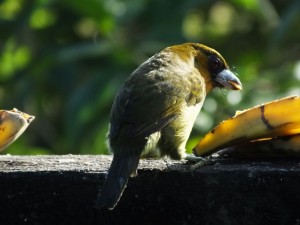For a while, I have been wanting to visit Catarata del Toro for a full day of birding. I have wanted to go there because it seems like the closest chance to get into middle elevation forest that hosts Black-breasted Wood-Quail, Azure-hooded Jay, Scaly-throated Foliage-gleaner, Tawny-throated Leaftosser, and chances at various other cloud forest goodies. The mentioned species are especially important because we need images of them for the Costa Rica Birds Field Guide app and the Panama Birds Field Guide app. Those birds also live closer to home but in much less accessible areas of Braulio Carrillo, or on the other side of the urbanized Central Valley at Tapanti. Not to mention, there has been little birding on the trails at Catarata and I suspect that it could host some surprises. As I write, I have yet to reconnoiter the site because one cold front after another has postponed the trip. When a cold front happens in Costa Rica, it’s not exactly cold (although locals might feel different about the slightly cooler temperatures). Instead, we get an abundance of rain and wind, especially in the mountains and on the Caribbean slope- basically right where Catarata is situated.

This is why I did not go there this past weekend but opted for a drive down to Chomes instead. Although I need fewer images of birds from the Pacific coast, a visit to this hotspot is always worthwhile because you really never know what you are going to see. I was reminded of this yesterday when an image of a White Tern was posted on the AOCR Bird Alarm from the other side of the Nicoya peninsula. When I saw it, I nearly fell out of my seat because a sighting in Costa Rica of this fairy-like bird usually requires a long, pelagic trip to Cocos Island. Needless to say, to see one from land would be a serious avian lottery win. I didn’t have the lifer winning ticket at Chomes but really, that bird could have just as well appeared later the same day or have been visible from the ferry, and it’s probably not the only major rarity down that way either!
So, in addition to keeping an eye out for any unusual, mega vagrants, here is some information when visiting Chomes and nearby during birding season, 2016:
- Stick to high tide: This really is a must. I checked out Punta Morales that same day during low tide and saw maybe three waterbirds. Compare that to hundreds of shorebirds and terns often there during high tide and you get the picture.

If there during high tide at least you can still see Mangrove Yellow Warbler. - Punta Morales: Speaking of this site, this is always worth a visit when birding around Chomes. To check the salt ponds, take the road to Punta Morales from the highway shortly after the turn off for Chomes, drive on in for several kilometers, and watch for the bar-restaurant El Huevo on the left. Take the next left, just before a bus stop and head on in until you see the ponds.

The scrubby vegetation also hosts White-lored Gnatcatcher and some other dry forest species. - Cave Swallows have been seen: I doubt these will be around in a month or two but they have been reported from Chomes and other nearby areas in recent weeks. I also had several around there last January.
- Chomes might be dry: It’s hard to make any predictions about water levels as Chomes but last weekend, it was much drier than I expected. The dry conditions seem to keep the Mangrove Rails out of reach, and doesn’t provide as much habitat for shorebirds. The only pond that had any water was the last one, near the beach. This did have some birds and probably hosted a lot more during high tide. Although we can’t expect any rain for Chomes any time soon, I suppose that tidal surges could fill the ponds near the beach.
- Bird the beach: What I really mean to say is scan the gulf from the beach. This is where the birds go during low tide and although they aren’t as concentrated and are further away, I still managed to identify American Oystercatcher, Black Skimmer, Marbled Godwit, and some other cool year birds.
- American Avocet and Long-billed Curlew: If these birds interest you, once again, at least one avocet is present and there are probably three curlews around.
As usual, bring plenty of water, slather on the sunscreen, and make sure that the vehicle is in good working order because you don’t want to be stranded in that outdoor oven!











